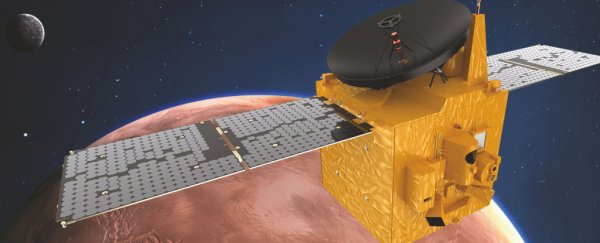The United Arab Emirates is about to launch its first mission to Mars. It will be the Arab world's first flight to another planet.
The SUV-sized spacecraft, called the Hope probe, will spend seven months travelling to Mars. Once it arrives, Hope will study the red planet's atmosphere by monitoring how it interacts with solar wind and tracking its loss of hydrogen and oxygen.
Its goal will be to chart a global map of the planet's climate across an entire Martian year.
That would be humanity's first such picture of Mars's atmosphere.
"We'll be able to cover all of Mars, through all times of day, through an entire Martian year," Sarah Al Amiri, science lead for the mission and the UAE's minister for advanced sciences, told Nature.
 The UAE's Hope orbiter. (United Arab Emirates Hope Mars Mission)
The UAE's Hope orbiter. (United Arab Emirates Hope Mars Mission)
Because of its large, oval-shaped orbit, Hope should be able to capture most of the planet in each of its 55-hour orbits.
"The Emiratis were very keen to make this not just a technology demonstrator, but make it contribute to the scientific understanding of Mars," Richard Zurek, chief scientist for the Mars Program Office at NASA's Jet Propulsion Laboratory, told Nature.
The probe is set to launch from the Tenaghashima Space Centre in Japan at 4:51 pm Eastern Time on Tuesday. It will be early Wednesday morning in Japan.
Hope is one of three missions poised to launch for Mars in the final weeks of July. NASA plans to launch its next Mars rover, called Perseverance, on July 30. China is also gearing up to launch a rover, along with its own Mars-orbiting spacecraft, before the month is over.
The launches are scheduled so close together because they must catch Mars as it passes close to Earth in the planets' orbital paths. If the agencies involved miss this chance, they won't have another opportunity to launch until 2022.
If all goes well, the Hope probe will reach Mars by February 2021 and study the planet from above for two years.
Watch the UAE's livestream of the launch below.
The Japanese launch provider, Mitsubishi Heavy Industries, will also broadcast the launch live:
This article was originally published by Business Insider.
More from Business Insider:
